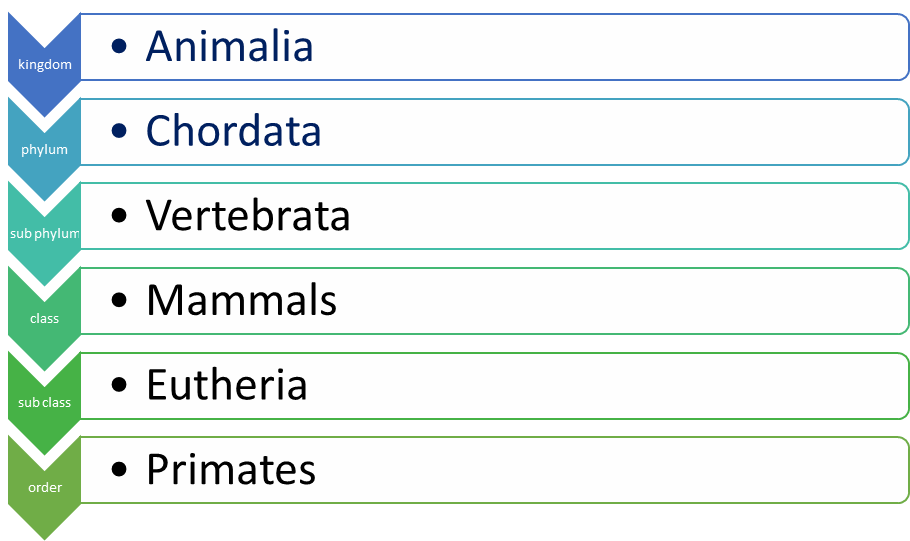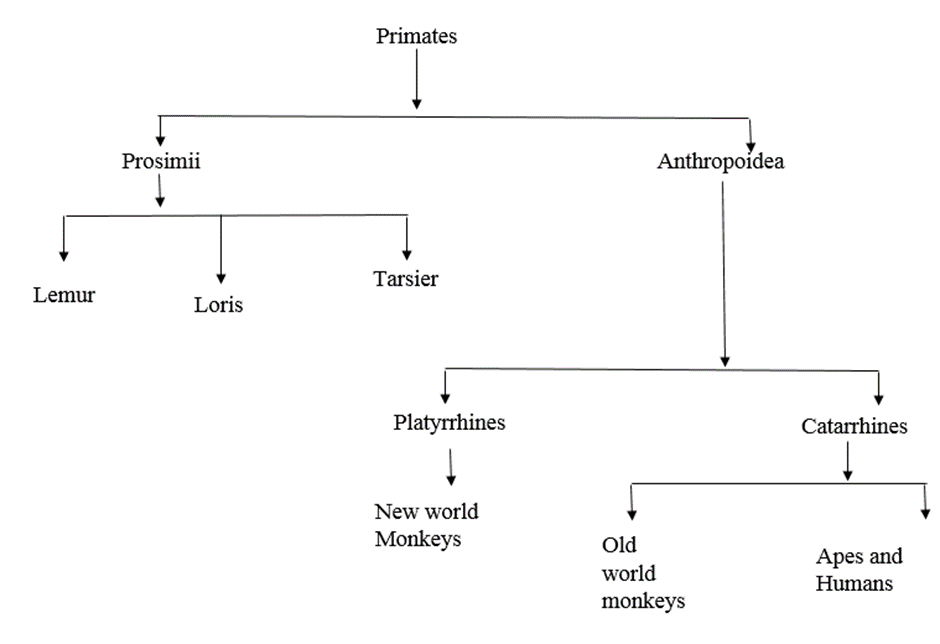AI Answer Evaluation Platform Live Now. Try Free Answer Evaluation Now
Primates
Primates are members of the phylum Chordata and the Kingdom Animalia. The primates belong to the Mammalia order. They are therefore a specific kind of mammal. Between 85 and 55 million years ago, primates began to evolve. They descended from tiny land animals. Compared to other animals, they have a brain that is significantly larger. One of the most sociable creatures that prefers to live in groups are primates. Primates are distinct from other species of mammals due to a number of distinctive traits. Currently, almost 60% of primate species are in danger of going extinct.

The word primates, which means “prime, first rank,” comes from the Old French or French primat, a noun form of the Latin prefix primatus (Merriam – Webster, 2023). Because Carl Linnaeus considered this to be the “highest” order of creatures, he gave it the name. The terminology is rather ambiguous because the relationships between the various primatological groupings have only lately become well known. Ape, for instance, has been used interchangeably with monkeys or any other tailless, human-like primate.
Physical Characteristics
a) General Mammalian features
These are also present in other mammals.
- A pair of pectoral mammae and suckling of young ones with breasts
- Social relation between mother and offspring
- Warm blooded
- Differentiated teeth i.e. of four types
- Learn by trial and error
b) Specialised features
These features are present only in primates.
1.Ability to grasp
- The hands and feet of primates are prehensile. It is mainly because of independent mobility of digits and opposability of thumbs and large toes to varying degrees.
- Due to grasping habits, claws have been replaced by nails in most of the primates.
- Presence of plantar pad on the sole of their limb which provides larger friction for better grasping power.
2. Herbivorous nature: Nutritional factors have played an important role in shaping the course of evolution. Generally they are herbivores and frugivores while some are carnivores.
3. Use of forelimbs for exploration: For knowing objects, gathering food and putting food in their mouth.
4. Reduced use of smell: Primates are mostly arboreal. Sense of smell is more important on the ground than on tree branches. Consequently, olfactory lobes of the brain have been reduced. Muzzles and snouts have also been smaller.
5. Development of great visual acuity
- Most primates are able to see in colour and in three dimensions. It helps them in distinguishing the details of their environment. In arboreal life precise information of direction and distance is crucial.
- A great deal of what we consider about the primate’s intelligence may be due to the primate’s awareness of the environment.
- Most primates’ eyes are encased in bony sockets, a feature not found in any other mammalian skull.
- In primates the eyes have become larger and the orbits have shifted from comparatively lateral position to the front. Consequently, in anthropoids the optical axis is more or less parallel resulting in stereoscopic or 3D vision.
6. Changes in skull and brain
- Primates sit on branches and use forelimbs for exploration resulting in shifts of foramen magnum in downward and forward direction.
- The frontal, parietal and occipital bones have greatly increased in size. This is also in response to the great selective development of different lobes of the brain.
- Primate’s arboreal life requires sound balance, for that cerebellum has increased greatly in size.
- Increase in sensation and intelligence resulted in increase of cerebral hemisphere and associated lobes.
- Brain to body weight increased.
7. Reduction in the number of offspring at birth and prolonged dependency of offspring on parents. Due to hemochorial placenta and long uterine development, after birth they are dependent on maternal care. They require the transmission of learned behaviour which has resulted in social organisation. Postnatal growth is longer and sexual maturity takes longer time to achieve.
Primate taxonomy

Habitat
- Mostly in the New and Old Worlds’ tropical and subtropical climates.
- Never lived in Australia or the majority of the Pacific Ocean’s islands.
- Although there is evidence that the first primates also inhabited North America and Europe 55–50 million years ago.
Evolution of Primates
The primates may have developed in North America and Europe 55 to 60 million years ago, according to paleontological data discovered there.
Read our article on Evolution of Primates
https://anthroholic.com/evolution-of-primates
Plesiadapis is said to be the oldest primate-like mammal or proto-primate. They were discovered in North America and Europe throughout the Cenozoic era, and it is thought that they vanished by the end of the Eocene.
Primate fossils from the Eocene era have been discovered in North America, Asia, and Africa. They looked like modern lemurs. Monkeys are thought to have originated in the old world (Europe, Asia, and Africa) and travelled to the new world (America) on logs or with floating islands.
Because of this, new world and old world monkeys had various adaptive radiations over a period of 30 million years, resulting in reproductive isolation.
In the Oligocene era, prosimians began to evolve. The evolution of all currently extant monkeys began about 30 million years ago.
There are currently between 230 and 270 species of primates, according to recent estimates.
Classification of Primates

Although evolutionary classifications have been performed, the classification of primates is mostly based on the similarities and differences of their external morphology. Strepsirrhini (Prosimii) and Haplorrhini (Anthropoidea) are the two suborders that make up primates (Britannica, 2016).
1. Strepsirrhini
They are huge, hairless, and their nose tips are wet. Of all the primate suborders, they were the earliest to emerge. The terms “Prosimians” and “lower Primates” are also used to describe them. “Pre-Monkey” is what prosimians are. This group of creatures includes Lemurs, Lorises, and related creatures. The majority of the world’s tropical regions are home to them.
- Lemur: Only the islands of Madagascar and the adjacent Comoro Islands contain them. There are currently about 22 species of arboreal lemurs. There are still five lemur families present.
- Lorises: They are primarily found in south-east Asia and India. Despite eating simple prey like insects, eggs, and young birds, they are omnivores and arboreal. They enjoy the night; they are nocturnal.
- Tarsier: Southeast Asia is home to enormous rodent-sized tarsiers. Both prosimian and monkey-like characteristics apply to them. They are genetically distinct from both groups, but in significant ways. Their natural habitat is in the Celebes Islands, Borneo, and the southern Philippines. At least seven tarsier species still exist, and they mostly rely on their eyesight and hearing while having a limited sense of smell. Possess the ability to create ultrasounds for internal communications. Capable of a greater than 180° head rotation. Strictly carnivorous and nocturnal.
2. Haplorrhini
They have a flat nose. Referred to as “Anthropoids” and regarded as “higher primates”. This suborder includes 145 species that are currently living. Over 90% of those are monkeys, with the remainder being apes and humans. Earth’s most successful primates.
- Platyrrhines: Wide septum separating a flat nose with sideways protruding nostrils. Dental formula – 2132 or 2133. Only found in the tropical forests of central and southern America, including southern Mexico. Exclusively herbivorous and arboreal.Many members use the tail as a third hand. 53 species are distributed throughout 2 families, Cebidae and Callitrichidae. Squirrel and Capuchin monkeys, night and titi monkeys, howler and spider monkeys, uakaris, and sakis are all members of the family Cebidae. Marmosets and tamarins are members of the Callitrichidae family.
- Old world monkeys: Nostrils that extend downward and have a thin, tiny septum between them. People who live in Africa, the Middle East, and south and east Asia. consists of 7 species in the families Cercopithecinae and Colobinae. Baboons, Mangabeys, Mandrills, Guenons, Patas Monkeys, and Macaques are all members of the genus Cercopithecines. The most successful way for macaques to spread over the world is through being primarily used in clinical research. Colobus monkeys are another name for them. They have sacculated stomachs, which aid in improved plant material digestion.
- Apes and Humans: Both are members of the Superfamily Hominoidea, which is further divided into the Hominidae (orangutans, gorillas, chimpanzees, and humans) and Hylobatidae (gibbons) groups.
- Gibbons: Also known as lesser-apes. They are monogamous and good brachiators (suspensory climbers). Largest and most elusive Asian apes are orangutans. Usually quadrupedal when walking. Confronting the threat of extinction.
- Apes:
- Gorillas: The largest apes are gorillas. They are “Quadrupedal knuckle walkers” . Only 786 gorillas were left in the world as of 2011.
- Chimapnzee: Compared to gorillas, chimpanzees are more similar to humans. Intelligent, mostly amiable creatures who walk on four legs like a gorilla. Their interactions are frequently deadly, aggressive, and highly loud.
- Bonobos: Chimpanzees’ close relatives. Referred to as tiny chimpanzees at times.
- Humans: Only extant species is Homo sapiens, or humans. Displays sexual dimorphism to other apes. The same internal organs, same bones, and some blood types are shared by humans and African apes. Bipedalism and an upright posture because of altered pelvic bones, spinal column, and ribs. The DNA base-pair sequences of humans and chimpanzees are 96% identical. This demonstrates that 6-7 million years ago, the two species diverged into separate species from a common ancestor.
Conclusion
The Order Primates is a distinctive and endearing group of animals united in sharing a range of traits that set us apart from other groups of mammals, including visual ability, gripping hands and feet, wide brains, and sophisticated life histories.
We are interested in studying a variety of distinguishing traits, including as nutritional, locomotors, and behavioural characteristics that distinguish the various species of extant primates. Non-human primates provide an essential aid for understanding our current biology because of our long evolutionary history with them.
References
- Britannica, T. Editors of Encyclopaedia (2016, April 7). list of primates. Encyclopedia Britannica. https://www.britannica.com/topic/list-of-primates-2060305 . Accessed on 21 May 2023.
- Definition of primate. (2023). In the Merriam-Webster Dictionary. https://www.merriam-webster.com/dictionary/primate
- Fleagle, J. G., Janson, C., & Reed, K. (1999). Primate Communities. Cambridge University Press.
- Fleagle, J. G., & Reed, K. E. (1996). Comparing primate communities: a multivariate approach. Journal of Human Evolution, 30(6), 489–510. https://doi.org/10.1006/jhev.1996.0039 . Accessed on 21 May 2023.
- King, F., Yarbrough, C., Anderson, D. Z., Gordon, T. P., & Gould, K. L. (1988). Primates. Science, 240(4858), 1475–1482. https://doi.org/10.1126/science.3287624 . Accessed on 21 May 2023.
- Napier, J. and Groves, . Colin Peter (2023, May 4). Primate. Encyclopedia Britannica. https://www.britannica.com/animal/primate-mammal . Accessed on 21 May 2023.
- Napier, J. and Groves, . Colin Peter (2023, May 4). Primate. Encyclopedia Britannica. https://www.britannica.com/animal/primate-mammal . Accessed on 21 May 2023.
- P, Nath. (2003). physical anthropology (2nd ed.). Higher Publishers, Patna.
- Tokeshi, M. Species Coexistence: Ecological and Evolutionary Perspectives. Oxford, UK: Blackwell Science, 1999.
- Tokeshi, M. Species Coexistence: Ecological and Evolutionary Perspectives. Oxford, UK: Blackwell Science, 1999.




